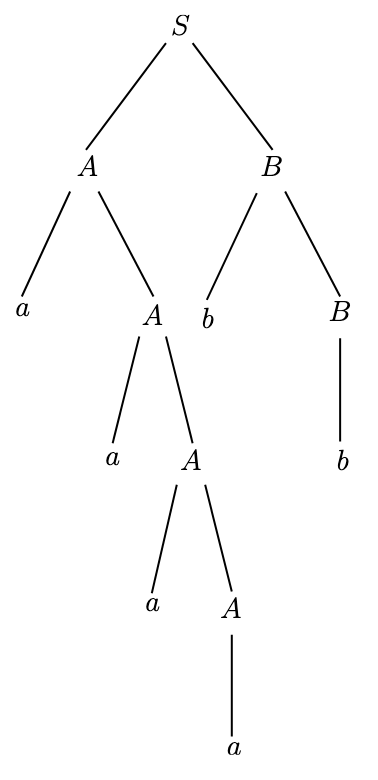
Racket tip:
There are a couple ways to “fake” imperative style (that is, “do this then do that”) in Racket:
(begin (do this) (do that))or
(let (bindings here) (do this) (do that))
Midterm wrapper due tonight
Today, we climb one level up the Chomsky Hierarchy to the next class of languages: context-free languages. Whereas:

We’ll start by describing context-free languages with grammars, and later we’ll see the machines that accept them.
Example: The following is a context-free grammar: \[ \begin{align*} S &\rightarrow AB \\ A &\rightarrow a\\ A &\rightarrow aA\\ B &\rightarrow b\\ B &\rightarrow bB\\ \end{align*} \] Each symbol in the grammar is either:
The grammar is composed of rules or productions. In this case, \(S\) is a special variable called the start symbol. Strings in the language described by this grammar can be created by deriving them from the start symbol. Here’s an example: \[ \begin{align*} S &\Rightarrow AB \\ &\Rightarrow aAB &\text{ (using $A \rightarrow aA$) }\\ &\Rightarrow aAbB &\text{ (using $B \rightarrow bB$) }\\ &\Rightarrow aaAbB &\text{ (using $A \rightarrow aA$) }\\ &\Rightarrow aaaabB &\text{ (using $A \rightarrow a$) }\\ &\Rightarrow aaaabb &\text{ (using $B \rightarrow b$) }\\ \end{align*} \] Notice that the symbol \(\rightarrow\) appears in the rules, whereas \(\Rightarrow\) is used to denote the application of one of those rules to a particular string.
Definition: Let \(A \in V\) be a nonterminal, and \(u, v, w \in (\Sigma \cup V)^*\) be strings, and suppose \(A \rightarrow w\) is a rule in the grammar. Then we say that \(uwv\) can be derived in one step fron \(uAv\); we write this \(uAv \Rightarrow uwv\).
We can generalize this to the operator \(\Rightarrow^*\), where \(u \Rightarrow^* v\) means means \(v\) can be derived from \(u\) in zero or more steps.
Definition: A context-free grammar is a 4-tuple \((V, \Sigma, R, S)\), where
Notice the important restriction that the left side of a rule must be a single nonterminal. This is what separates context-free from context-sensitive grammars.
Definition: The language of a grammar \(G\) is the set of all strings in \(\Sigma^*\) that can be derived (in any number of steps) from \(S\): \[ L(G) = \{w \in \Sigma^* : S \Rightarrow^* w\} \] Definition: A language \(A\) is context-free if there exists a context-free grammar \(G\) such that \(L(G) = A\).
Here’s a language that’s not regular but is context-free: \[ L = \{a^n b^n\} = \{\epsilon, ab, aabb, aaabbb, \ldots\} \] And here’s a grammar that generates it: \[ \begin{align*} S &\rightarrow \epsilon\\ S &\rightarrow aSb \end{align*} \] Here’s a derivation of \(aaabbb\):
\(S \Rightarrow aSb \Rightarrow aaSbb \Rightarrow aaaSbbb \Rightarrow aaabbb\)
Note on notation: we can write rules with the same left-hand side with \(\mid\), interpreted as “or”; the grammar above could be written: \[ S \rightarrow \epsilon \mid aSb. \] Sometimes we split these “or” productions onto multiple lines, as in \[ \begin{align*} B \rightarrow & b \\ \mid& bB \end{align*} \] though I haven’t yet found a great way to typeset this and have it look nice.
Consider the grammar and derivation from above:
\[ \begin{align*} S &\rightarrow AB \\ A &\rightarrow a\\ A &\rightarrow aA\\ B &\rightarrow b\\ B &\rightarrow bB\\ \end{align*} \]
\[
\begin{align*}
S &\Rightarrow AB \\
&\Rightarrow aAB &\text{ (using $A \rightarrow aA$) }\\
&\Rightarrow aAbB &\text{ (using $B \rightarrow bB$) }\\
&\Rightarrow aaAbB &\text{ (using $A \rightarrow aA$) }\\
&\Rightarrow aaaabB &\text{ (using $A \rightarrow a$) }\\
&\Rightarrow aaaabb &\text{ (using $B \rightarrow b$) }\\
\end{align*}
\] We can represent this derivation using a parse
tree, where each level of the tree is an intermediate string.
Every time a rule is applied, the nonterminal being substituted branches
into the characters that replace
it.
Consider the following grammar over the alphabet \(\Sigma = \{0, 1, \ldots 9, +, -, *, /, (, )\}\): \[ \begin{align*} E &\rightarrow E + E \\ E &\rightarrow E - E\\ E &\rightarrow E * E\\ E &\rightarrow E / E\\ E &\rightarrow (E)\\ E &\rightarrow 0 \mid 1 \mid 2 \mid 3 \mid 4 \mid 5 \mid 6 \mid 7 \mid 8 \mid 9 \end{align*} \] Consider the string \(1 + 1 * 4\). We can derive it in many ways! Three examples:
\(E \Rightarrow E + E \Rightarrow E + E * E \Rightarrow 1 + E * E \Rightarrow 1 + E + 4 \Rightarrow 1 + 1 + 4\)
\(E \Rightarrow E + E \Rightarrow 1 + E \Rightarrow 1 + E * E \Rightarrow 1 + 1 * E \Rightarrow 1 + 1 * 4\)
\(E \Rightarrow E * E \Rightarrow E * 4 \Rightarrow E + E * 4 \Rightarrow E + 1 * 4 \Rightarrow 1 + 1 * 4\)
These all get to the same string, but by a different route. Notice:
If we construct the parse trees for the above derivations, we’ll notice that we can get different parse trees. Specifically #1 and #2 yield the same parse tree, where #3 has a different one. Knowing what we know about order of operations, we’d probably hope to get the parse tree from #1 in this case (but notice that using the left-most derivation doesn’t solve this universally - the situation would be reversed for \(1 * 1 + 4\)).
Definition: A grammar \(G\) is ambiguous if there is some string \(w \in L(G)\) with more than one distinct parse tree.
Equivalent definition: A grammar \(G\) is ambiguous if there is some string \(w \in L(G)\) that has more than one left-most derivation.